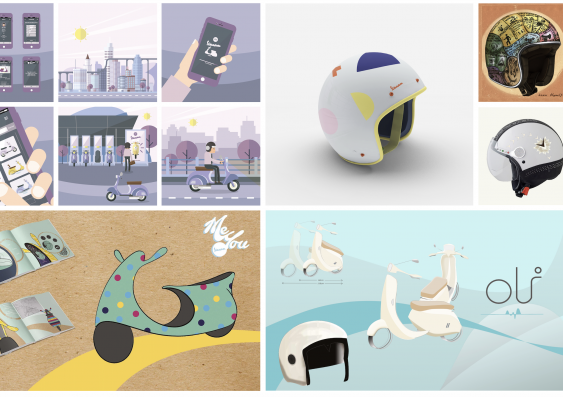UNSW students redesign Vespa scooter
A partnership between UNSW and Piaggio is creating innovative design concepts and prototypes through collaboration with art, design and engineering students.
A partnership between UNSW and Piaggio is creating innovative design concepts and prototypes through collaboration with art, design and engineering students.

Susi Banks
Media & Content
0412 378 489
The UNSW Piaggio Lab is inviting students from Art & Design and Mechanical Engineering faculties to design and prototype concepts for the next generation Vespa scooter.
The project is the continuation of a collaboration between Vespa and UNSW Art & Design which is expanding to include UNSW Mechanical Engineering students this year.
The inclusion of the engineering students will take the project beyond concepts and illustrations to prototyping, and is supported by the provision of Vespa scooters and parts by Piaggio to inform the work.
The partnership between UNSW and Piaggio creates innovative design concepts and prototypes through collaboration by art, design and engineering students.
Commerce/Design double degree student Emily Kong worked on the Art & Design project in semester one this year. She said it was a great opportunity to work with an iconic brand.
“It was definitely something I did not expect to encounter for a university project. I feel that we UNSW design students are extremely lucky to gain such experience.”
She supported the new collaboration with Mechanical Engineering students.
“There is a lot of potential for creating feasible, innovate solutions for the Vespa project. Collaboration between Design and Engineering could lead to some incredible outcomes and concepts that go beyond sketches and prototypes. I would encourage future students to take the Vespa project seriously as both a learning experience and opportunity to gain recognition as designers, working with a famous brand,” Ms Kong said.
Australian lifestyle
The project began in 2016 as a competition run by Piaggio Vespa Australia which was open to second and third-year Art & Design students studying in the graphics stream of the Bachelor of Design. The project challenged them to produce a campaign communicating how Vespa was part of the contemporary Australian lifestyle.
The result was a huge success, and the project became embedded in the Bachelor of Design degree as part of the Graphics Media stream.
Since then Art & Design students have worked on a range of client-driven briefs around diverse themes such as positioning Vespa within the Australian cultural context, Vespa and the future of urban mobility and reinterpreting the Vespa helmet and the concept of visibility.
Associate Professor (Design), Ian McArthur, said it became clear that the Art & Design work needed to be informed by other aspects of Piaggio’s operations, such as engineering.
“We reached the point where graphic design students could visualise or create great concepts and ideas but couldn’t really take it further without other input. The idea came about in discussion with Engineering lecturer David Kellerman that we would create a collaborative elective with Mechanical Engineering” he said.
About 16 students have expressed interest in joining the project for term 3 this year, including six from Engineering, but Professor McArthur is keen for more engineering students to take part. “We are looking for more students to join the project – ideally a cohort of 24-25 students.”
To do well, students need to demonstrate evidence of rigorous independent and team research, addressing all aspects of a complex brief to produce a project proposal.
New opportunities for students
The new course will be run as an Art & Design Elective/General Education elective that is open to students from both faculties, who will receive six units of credit on completion. The course will be taught by tutors from Art & Design and Engineering.
It will take place primarily in the design rooms of Mechanical Engineering, Kensington campus, but some classes will be held at the Art & Design campus in Paddington. The makerspaces at both campuses will also utilised.
Second year Art & Design student Patrick Zamuco is doing a Bachelor of Design and a Bachelor of Media and has worked on the existing module. He said the project was “right up my alley, in terms of what I want to go into, with my career. Getting an actual brief that’s quite close to what you would see in the industry was a huge advantage.”
Another benefit was the opportunity to work collaboratively. “You learn a lot about yourself when you work in a group; your strengths, your weaknesses. I think that is something that is going to be useful, no matter what. In a lot of jobs you have a lot of collaboration.”
He was interested to learn about the origins of the name ‘Vespa’.
“Vespa means ‘wasp’ in Italian,” he said. The name comes from when Enrico Piaggio first saw the design in 1946 and exclaimed: “It looks like a wasp!”
Professor McArthur said there was scope for Built Environment and Business degrees students to be involved in future.
UNSW Engineering faculty academic David Kellerman spoke about his collaboration with Professor McArthur: “The practice of modern product design incorporates the connection between form and function, between art and engineering. Getting students from both sides of the fence working together will be a great way to give our graduates more relevant experience.”
Professor McArthur said that the Italian scooter company was looking to expand in Australia and was interested to find out how young people perceived their brand.
“We worked with Nicola Capello, Piaggio’s Asia Pacific business development manager. Originally, he was based in Sydney but then relocated to Singapore. Their regional offshore manufacturing base is in Vietnam,” said Professor McArthur.
“They’re fantastic people to work with. They are very supportive and open to ideas and appreciate that the Schools run quite differently to industry.”
Professor McArthur said design should be integrated throughout the University and the Faculty. “And that's actually very difficult to achieve. It's very difficult to create cross-faculty collaboration, so it's great that we've got this far.”